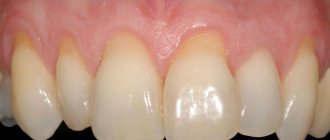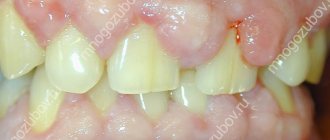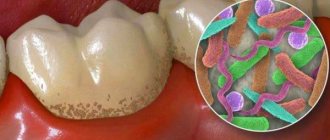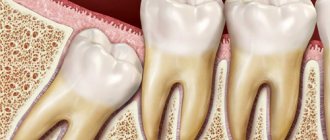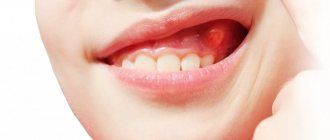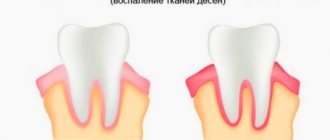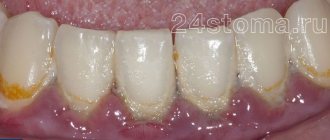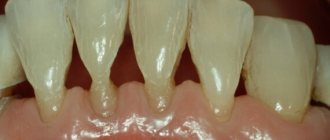What is gum recession
Normally, the gum tissue fits tightly to the surface of the tooth in the cervical area. It happens that for some reasons (about them in the next subsection of the article), the edge of the gums drops, exposing the neck of the tooth. This is called a recession. This defect is not only a deterioration in the aesthetics of a person’s appearance, but also the occurrence of negative consequences for teeth, bone tissue and, ultimately, for the health of the body as a whole. Without adequate measures, the prolapse can progress, exposing the tooth root. Pathology can develop at any age.
Artificial gum method
With this method, a crown with an artificial gum is installed, which imitates the real one in color and shape. The gingival margin here is always clearly defined, the height of the teeth is anatomically correct, and the smile is attractive. The edge of the gums and papillae (small triangles between the teeth) are modeled from a special material, so the structure looks natural. Patient photographs clearly demonstrate the attractive aesthetics of such restoration.
Reasons for the formation of a recession
The main reason for receding gums is poor circulation in the tissues surrounding the tooth (i.e., periodontal disease).
The periodontium not only holds the tooth in the alveolus, but also nourishes the bone tissue. Without proper nutrition, bone atrophy begins, which, among other things, provokes gum loss. The process can be caused by a number of factors. What causes receding gum line:
- insufficient oral hygiene;
- improper brushing technique;
- formation of periodontal pockets;
- periodontal diseases;
- poor-quality dentures or incorrectly installed braces;
- mechanical, thermal and chemical injuries to the gums;
- pathologies of occlusion (malocclusion);
- metabolic disease;
- lack of nutrients and vitamins in the diet;
- age-related changes (physiological recession).
Pathologies
Factors that can trigger gum disease include mechanical damage, poor hygiene, infection, and the development of ulcers or cancer. Characteristic signs of deviation from the norm are loss of sensitivity, the formation of edema, bleeding and abundant accumulation of plaque on the surface. Common diseases include:
- Gingivitis is an inflammatory process that occurs as a result of chronic pathologies, errors in the selection of prosthetic structures, as well as tartar deposits.
- Periodontitis is an inflammation of bone tissue, often developing from a local to an extended form. It becomes the result of infection or food debris getting into the gum pockets, and, in the absence of proper treatment, leads to a weakening of the structure of the dentition.
At the first signs of abnormalities, it is recommended to undergo diagnostics at a dental clinic. Timely identification of the cause of gum disease allows comprehensive treatment to begin and helps to avoid serious consequences.
Symptoms and stages of receding gums
Recession of gingival tissues in itself is not a disease, but a condition that occurs with the progression of any pathology. A recession is accompanied by the following symptoms:
- the appearance of bleeding, swelling and “looseness” of the gums;
- change in the color of the gum tissue (in the initial stage to a whitish tint, in the advanced stage - blue);
- drooping gum line;
- bad breath;
- increased tooth sensitivity to external irritants: hot, cold, sweet, sour, brushing teeth, etc.;
- loosening of dental elements.
The diagram shows each stage of recession progression. The first stage, as a rule, goes unnoticed by the patient. The second can be detected only when additional signs appear (swelling, slight bleeding). Therefore, it is very important to visit the dentist for a preventive examination at least twice a year. A specialist, even without the presence of secondary symptoms, will be able to promptly detect the beginning of the gingival margin. The sooner the problem is diagnosed and the sooner adequate measures are taken, the more effective the treatment will be.
Note: the network of clinics “Smile” is equipped with modern diagnostic equipment. Our dentists work using dental microscopes, so they are able to detect recession at the very first stage.
Which method is better
There is no treatment that suits everyone, so the dentist decides which method to use based on the clinical picture and the data collected. Tissue augmentation may be impossible for a number of reasons, or artificial gum cannot be used for various reasons. Large clinics will consider both options because they have the basis for using either option. In small dentistry, the doctor may lack experience in tissue transplantation, or the technicians may not have the material to make artificial gum on the prosthesis.
Treatment of recession
Treatment of gum recession is a complex of therapeutic and surgical measures taken to raise the gingival margin to a normal level. In the early stages of recession, conservative measures are effective; in the later stages, surgical intervention followed by drug therapy is necessary. The first priority is to identify the cause of receding gums. Without its elimination, recession treatment will not bring long-term results. For example, if a defect appeared as a result of gum disease, then without treatment, even after surgical lifting of the gingival margin, after some time the defect will reappear.
Important: experienced dentists (therapists, periodontists, surgeons) practice in our network of clinics. This allows for effective treatment regardless of the stage of recession. Experts warn: the sooner treatment is started, the faster it will be completed.
Non-invasive (conservative) treatment methods
The appearance of the first signs of a beginning recession is a signal for an immediate visit to the periodontist. At the very beginning of the disease, the problem can be solved without surgery. But the patient should prepare for a long, complex course of treatment. First, it is necessary to eliminate existing and potential foci of infection in the oral cavity. This means that you need to cure dental diseases (if any) and perform professional teeth cleaning using a hardware method. The second stage will involve curettage of periodontal pockets, after which local anti-inflammatory therapy (treatment of gums with special gels, ointments, solutions) will be prescribed. If necessary, the doctor will prescribe a course of antibacterial therapy (taking antibiotics).
How to prevent gum inflammation?
WHO recommendations propose a program for the prevention of gum inflammation, where special attention is paid to health education on oral hygiene, explanation of the importance of proper brushing of teeth, a nutritious diet and its structure, risk factors that disrupt the normal functioning of the periodontium, periodic examination of the oral cavity by a doctor and a healthy lifestyle .
To remove plaque, you need to visit a dentist every six months for professional teeth cleaning. You also need to thoroughly brush your teeth twice a day (after breakfast and before bed), and thoroughly clean the crowns of your teeth and the interdental spaces. Toothpastes are of great help in oral care.
To prevent gum inflammation, you should choose toothpastes with anti-inflammatory, antibacterial and plaque-removing effects. Preference should be given to those that contain substances that dissolve microbial plaque and prevent its further formation, for example enzymes. Additional assistance in the prevention of gum inflammation is provided by the use of rinses that neutralize microorganisms in hard-to-reach places in the oral cavity.
Currently, various rinses represent a promising link in the complex treatment of diseases of the oral mucosa and periodontal disease. The use of prophylactic rinses with combined herbal preparations has antimicrobial, anti-inflammatory and analgesic properties. Human acquaintance with the medicinal properties of plants dates back to ancient times, and in modern medicine medicinal plants not only have not lost their position, but are increasingly preferred today in the prevention and treatment of various diseases. Therefore, the medicinal plants used in the manufacture of professional mouth rinses are low-toxic and can be used for a long time without side effects.
Surgical methods for closing recession
Serious damage and atrophy of gum tissue cannot be treated conservatively. The type of surgical intervention depends on the severity of the defect and the factor that provoked it. In case of gum injury, the periodontist treats the affected area with antiseptics and applies sutures. If the defect is caused by tissue atrophy, then special surgical techniques are used. The choice of a specific technology depends on the indications. Methods for closing a recession:
- patchwork operation - a fragment of donor tissue taken from a healthy area of the patient’s mucosa is sewn onto the defect site (as in the figure above). Pros: ease of implementation, cons: the need to collect donor tissue, the possibility of rejection. You can read more about this method in another article on our website;
- tissue regeneration - carried out by engrafting a fibrin membrane into the area of recession. The membrane is formed from blood taken from the patient. Pros: no rejection, formation of a natural gum line, low invasiveness;
- implantation of collagen tissue - collagen is implanted into the recession, which resolves over time, forming the gingival margin.
The network of dental clinics “Smile” offers treatment services for gum recession. Contacting our branches has significant advantages:
- treatment is carried out by doctors of the highest category;
- all dental procedures are carried out in accordance with international standards;
- We provide family and cumulative discounts;
- Open daily until 21:00 (Sunday until 16:00).
You can make an appointment at any of the branches of our clinic in Moscow, located within walking distance from metro stations:
- Alekseevskaya (VDNKh district, etc. Mira), address: st. 3rd Mytishchiskaya house 3, building 2;
- Shelepikha, address: Shelepikhinskaya embankment, building 34, building 1.
Modern equipment and highly qualified doctors allow us to provide effective assistance in the treatment of gum recession. We guarantee effectiveness and safety. Your health is in good hands!
